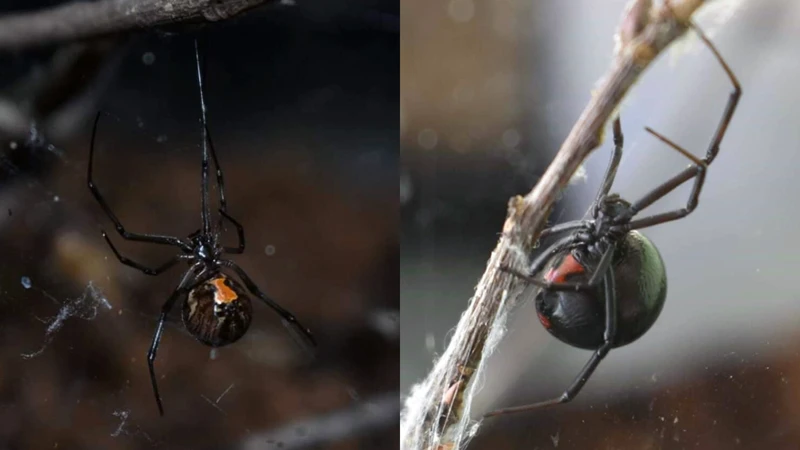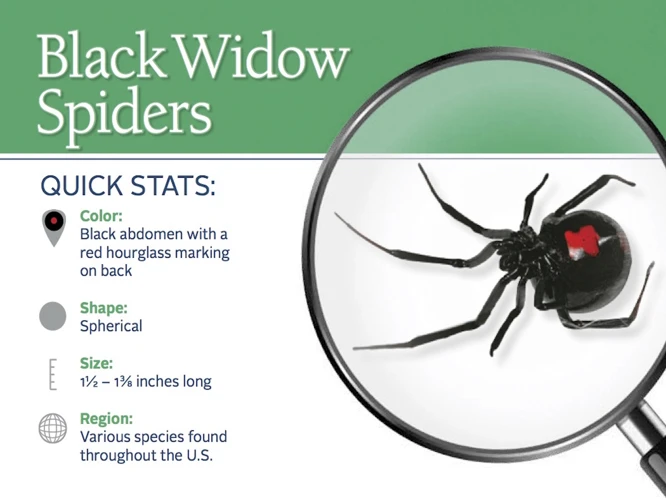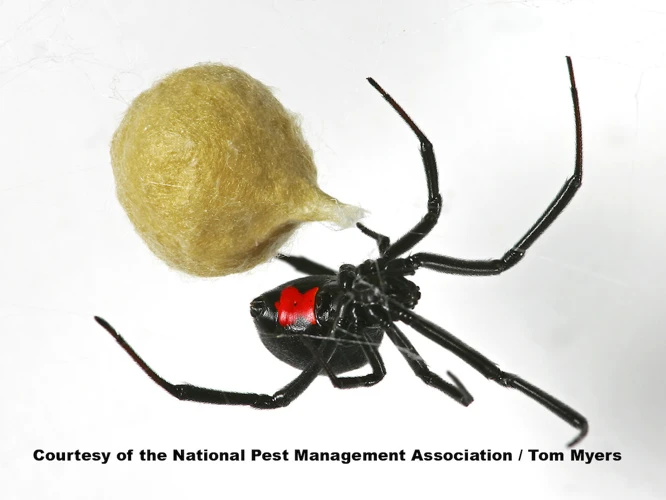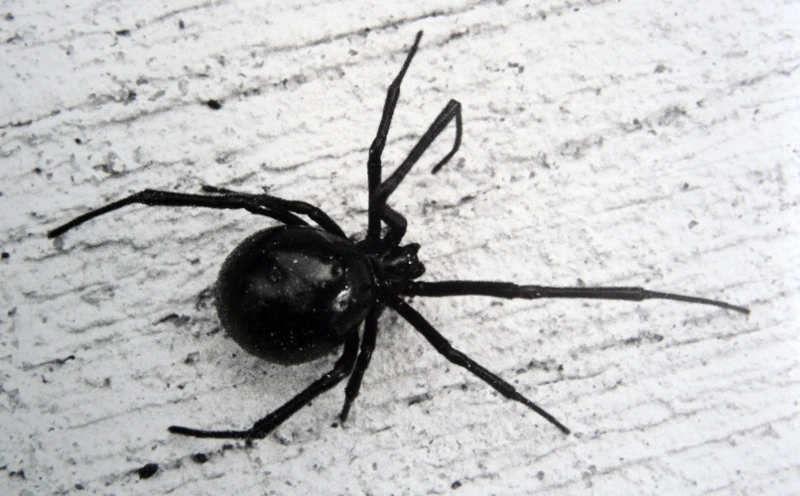Suburban areas may seem like a safe haven from the dangers of the wild, but the threat of black widow spiders can still be present. These venomous arachnids are notorious for their black bodies and red hourglass-shaped markings, and their presence in well-populated areas can pose a significant risk to human health. In this article, we will explore the identification, preference, risks, and prevention of black widow spiders in suburban areas. Whether you’re a seasoned homeowner or just settling into a new neighborhood, understanding these risks and how to prevent them can help keep you and your family safe from these deadly spiders.
Black Widow Spiders in Suburban Areas

Black Widow spiders are notorious for their venom and presence in suburban areas. It is important to learn about Black Widow spiders and their behavior in order to prevent an infestation from occurring in your home. These spiders are found in various habitats and have expanded their range due to human activity. Understanding the risks associated with Black Widow spider bites and how to prevent them from inhabiting your home can help protect you and your family. Let’s delve further into the world of Black Widow spiders and their presence in suburban areas.
Identification of Black Widow Spiders
Black Widow Spiders can be identified by their distinctive hourglass-shaped body. Females have a red or orange hourglass-shaped mark on the underside of their abdomen, while the males have a more fragmented mark or no mark at all. Black Widow Spiders have shiny, black bodies and eight long, spindly legs.
To differentiate Black Widow Spiders from other spiders in your area, it’s important to look for these specific identifying marks. Mistaking them for harmless spiders can be dangerous, so it’s important to be aware of the physical characteristics unique to Black Widow Spiders.
It’s worth noting that Black Widow Spiders are found throughout the world, but primarily thrive in warm, dark, and secluded areas. It’s crucial to know more about their habitats and preference. If you want to learn more about biomes where Black Widow Spider thrive, click on this link to our previous article.
If you’re not sure of what type of spider you’ve encountered, try to observe it from a safe distance without disturbing it. Additionally, contacting pest control experts can assist with spider identification.
Fun Fact: There are many different species of Widow Spiders, but the Black Widow Spider is the most well-known and feared. Curious about global range expansion and human activity impact on Black Widow range? Then follow this link to our detailed article on the subject.
Preference of Black Widow Spiders in Suburban Areas
Black widow spiders are known to prefer suburban areas due to the abundance of shelter, food sources, and warmth that they provide. These spiders typically gravitate towards undisturbed areas such as cluttered garages, woodpiles, and unused areas of the yard. They may also seek refuge in protected areas of the home, such as attics and basements.
Black widow spiders have a unique preference for certain types of habitats:
- They prefer dark and quiet environments, such as basements, closets, and storage areas.
- They like to build their webs in the corners of rooms, under furniture, and in other protected areas.
- They like to be near a source of food, which for them includes other insects such as moths, flies, and mosquitoes.
- They prefer areas with a warm and humid climate, which is why they are often found in southern states.
It is important for individuals living in suburban areas to be aware of these spider’s preferences so they can take preventive measures to avoid infestations. These preventive measures can include reducing clutter, sealing up cracks in the home’s exterior, and addressing other insect infestations in and around the home.
If you are concerned about black widow spider infestations in your area, it is important to learn more about their habitat preferences, as well as their behavior and potential risks. For more information, visit the global black widow spiders page on our website.
Risks of Black Widow Spider Infestation

The presence of black widow spiders in suburban areas can pose serious risks to both your health and the well-being of your home. It’s important to understand the potential dangers associated with these venomous spiders and take appropriate measures to prevent infestations. From the potential health risks of black widow spider bites to the damage they can cause to your home, the risks of black widow spider infestation are no joke. Let’s explore these risks in more detail. To learn more about the potential health risks of black widow spider bites, check out our article on black widow spider envenomation.
Potential Health Risks of Black Widow Spider Bites
Black Widow Spiders are known for their potentially venomous bites. Their venom contains a neurotoxin that can affect your nervous system. In some rare cases, their bites can be fatal, especially in children, elderly adults, or people with existing health problems. Strong symptoms of a bite include severe muscle aches, cramps, and spasms, which can affect respiratory and cardiovascular systems, leading to difficulty in breathing, fast heart rate, and high blood pressure.
If experiencing these symptoms, it is important to seek medical help immediately. Healthcare professionals typically ask for a description of the spider and the time of the bite to determine the necessary treatment options. As black widow spiders are most commonly found in Southern US regions, the chances of a fatal bite increase in places with warmer climates, lower altitudes, and suitable habitats.
To avoid this health risk, it is essential to take preventive measures described in previous sections of this article, such as keeping your house clean and clear of clutter, sealing cracks and holes, and eliminating other insect infestations. By following these tips, you can significantly reduce the chances of a run-in with a black widow.
Black widow spider bites can be extremely dangerous and potentially life-threatening, especially in vulnerable groups. Thus, it’s crucial to take precautionary measures in places where black widows are common. Nevertheless, there has been an increase in conservation efforts aimed at preserving black widow populations in European regions experiencing a relatively mild climate. However, it’s essential to remain cautious in areas where these spiders are known to thrive.
Effects of Infestation on your Home
When black widow spiders infest a home, they can cause significant damage and pose a serious health risk to its inhabitants. Black widow spiders tend to build their webs in dark, secluded areas such as basements and attics, which can make it difficult to detect an infestation until it’s too late. Here are some of the possible effects of a black widow spider infestation on your home:
| Effect of Infestation | Description |
|---|---|
| Damage to Property | Black widow spiders can spin their webs into tight crevices and gaps, causing damage to property over time. Their webs can be especially damaging to electrical systems and insulation. |
| Health Risks | As previously mentioned, black widow spiders are venomous and their bite can cause serious health problems. It’s important to seek medical attention immediately if you suspect you’ve been bitten. |
| Emotional Distress | For some individuals, the presence of spiders can cause significant emotional distress and anxiety. An infestation could lead to sleeplessness, difficulty concentrating, and other emotional health concerns. |
It’s clear that a black widow spider infestation can cause a host of problems for homeowners, which is why prevention and removal should be taken seriously. By implementing the prevention techniques outlined below, you can help ensure that your home remains free from black widow spiders and their negative effects.
Prevention Techniques

Taking steps to prevent black widow spider infestations in your suburban home is crucial to ensuring the safety and wellbeing of your family. Implementing effective prevention techniques can significantly reduce the likelihood of encountering these venomous spiders. By reducing clutter, sealing cracks and holes, and eliminating other insect infestations, you can minimize the attractiveness of your home to black widow spiders. In the next sections, we’ll discuss some of the key prevention measures you can take to safeguard your home. Additionally, understanding the habitats and preferences of these spiders can also help you to prevent and minimize the potential risks of an infestation.
Reducing Clutter and Debris around Your Home
Reducing Clutter and Debris around Your Home is one of the most important steps in preventing black widow spider infestations in suburban areas. Black widow spiders are attracted to cluttered and messy areas because they provide them with a warm, dark and dry environment to nest in. To prevent such infestations, it is essential to keep your home and surroundings clean and well-organized.
Here are some tips to help you reduce clutter and debris around your home:
- Dispose of any unnecessary material or items that are lying around in and around your home, such as old newspapers, magazines, and cardboard boxes. Recycling or donating them is a good option too.
- Store all outdoor items such as garden equipment, unused patio furniture, and toys, in neatly organized sheds or garages where possible.
- Clean up any debris or dead vegetation around the perimeters of your home, as this can provide hiding places for spiders and other insects.
- Regularly clean and vacuum all corners of your home, including the basement, attic, and other hard-to-reach areas.
- Seal all food items and store them properly so that they do not attract insects and spiders.
By implementing these measures, you can significantly reduce the likelihood of black widow spiders nesting in and around your home. Keep in mind that prevention is always better than cure, and a clean and well-organized home is less likely to harbor pests and insects, including black widow spiders.
If you want to know more about the preference and habitats of black widow spiders, follow this link to an informative article on the topic.
Sealing Cracks and Holes in Your Home’s Exterior
One effective technique for preventing black widow spider infestations in suburban areas is to seal cracks and holes in your home’s exterior. These tiny openings are easy entry points for spiders and other insects.
If you want to effectively seal your home’s exterior, you will need to inspect it for cracks and holes. You can do this by walking around the perimeter of your home and searching for entry points. Common areas of concern include windows, doors, pipes, and electrical wiring. Once you have identified the areas where spiders can enter your home, you can start sealing them up.
DIY or Professional Help?
You can choose to seal the cracks and holes in your home’s exterior yourself or hire a professional to do it for you. DIY methods include sealing gaps and holes with caulking or weatherstripping, using foam sealant, or installing mesh screens over vents and windows. However, if you don’t feel confident in your ability to do the job effectively, it’s best to hire a professional to ensure that the spider-proofing of your home’s exterior is done correctly.
The Benefits of Sealing Cracks and Holes in Your Home’s Exterior
Sealing your home’s exterior can keep out not only black widow spiders, but also other pests such as ants, cockroaches, and mice.
Keeping these pests out of your home not only protects your household health but also prevents damage to the structure of your home. By sealing off the spider’s entry points, you can also prevent a potential infestation from taking root, saving you money on costly extermination fees down the line.
Conclusion
Sealing cracks and holes in your home’s exterior is an effective technique you can use to prevent black widow spider infestations in suburban areas. By doing so, you not only protect your home from potential damage but also safeguard the health of your family. Be sure to inspect your home’s exterior regularly and seal any gaps that may allow unwelcomed guests into your home.
For more information on black widow spiders and their prevalence, check out our article on the climate of black widow spiders.
Eliminating Other Insect Infestations
Eliminating Other Insect Infestations is an important step in preventing the infestation of black widow spiders in suburban areas. This step is essential because other insects often attract black widow spiders, as these spiders feed on insects, such as mosquitoes and flies. It is essential to reduce the number of insects in the surrounding area to minimize the risk of black widow infestation.
Techniques for Eliminating Other Insect Infestations
| Technique | Description |
|---|---|
| Keep Garbage Sealed | Seal all garbage cans tightly to avoid attracting flies. Flies are a primary source of food for black widow spiders. |
| Use Window Screens | Use window screens to prevent insects from entering your home; mosquitoes are often a common target for black widow spiders. |
| Remove Standing Water | Remove all standing water near your home, as it can attract mosquitoes and other insects. |
| Elevate Your Plants | Keep potted plants elevated from the ground as this helps to prevent ground insects from being attracted to your home and garden. |
| Use Insecticides | Use insecticides to kill any insects in the home that can attract black widow spiders. |
By eliminating other insect infestations in and around your home, you can create a less attractive environment for black widow spiders. Removing food sources and preventing insects from entering your home can reduce the chances of an infestation of black widow spiders.
Removing Black Widow Spiders from Your Home
Dealing with a black widow spider infestation in your suburban home can be a daunting task. Despite your best efforts at prevention, it is still possible for these venomous arachnids to make their way into your living space. In this section, we will discuss effective techniques for removing black widow spiders from your home. It’s important to note that attempting to remove these spiders without proper knowledge and precautions can be dangerous, so it’s crucial to take the necessary steps for safe removal.
Safe Removal Techniques
Removing black widow spiders from your home can be a dangerous task, so it’s important to take the necessary precautions to avoid bites. Here are some safe removal techniques that you can use:
1. Wear protective clothing: Before removing black widow spiders, it’s important to wear protective clothing such as gloves, boots, and long-sleeved shirts and pants. This will protect your skin from potential bites and also help prevent the spiders from crawling onto your clothes.
2. Use a jar or container: Place a jar or container over the spider, and then slide a piece of paper or cardboard under the jar so that you can safely trap the spider inside. This technique will allow you to remove the spider from your home without getting too close to it.
3. Vacuum the spider: If you’re dealing with a small infestation, you can try using a vacuum cleaner to remove the spiders. Be sure to place a stocking or a piece of cloth over the end of the vacuum wand to prevent the spider from crawling into it.
4. Hire a professional: If you’re dealing with a large infestation or are unsure of how to safely remove the spiders yourself, it’s best to call in a professional pest control company. They can safely remove the spiders from your home using specialized equipment and techniques.
Remember to always handle black widow spiders with caution, as their venom can be dangerous. If you do get bitten by a black widow spider, seek medical attention immediately. It’s also important to note that black widow spiders are vital to our ecosystem and play an important role in controlling insect populations. If possible, consider more humane methods of removal or relocation rather than simply killing them.
As a side note, for those interested in black widow spiders from a conservation perspective, check out our article on conservation efforts for the black widow spider. While black widow spiders are not native to Europe, they have recently been found in some parts of the continent. Learn more about this discovery and its potential impact in our article on black widow spiders in Europe. And for a more in-depth analysis of black widow bite fatalities in relation to geographic location, see our article on black widow bite fatalities around the world.
Conclusion
After reading this article, it’s clear that black widow spiders can be a serious problem for suburban homeowners. These spiders are easily identifiable by their distinctive black body and red hourglass-shaped marking. They tend to prefer living in cluttered and debris-filled areas, making suburban areas a prime location for infestations.
The risks of black widow spider infestations are not to be taken lightly. Their bites can cause significant health problems, including muscle pain, cramps, and spasms. Additionally, their presence in and around your home can lead to a decrease in property value and an unsightly appearance.
Fortunately, there are several prevention techniques that homeowners can implement to reduce the risk of a black widow spider infestation. Reducing clutter and debris around the outside of your home, sealing any cracks or holes in your home’s exterior, and eliminating other insect infestations are all effective strategies.
If you do find black widow spiders in your home, it’s important to remove them safely using established techniques. This may involve traps, sprays, or calling in a professional exterminator to eliminate the spiders entirely.
Overall, staying vigilant and taking proactive measures to prevent black widow spider infestations is essential for suburban homeowners. With the right prevention techniques in place, you can keep these harmful spiders at bay and enjoy a safe and healthy living environment.
Frequently Asked Questions
What are Black Widow Spiders?
Black Widow Spiders are venomous spiders that got their name from the belief that the female spider devours their male counterparts after mating, which only happens in rare circumstances.
What do Black Widow Spiders look like?
They are small, black spiders with a red or orange hourglass-shaped marking on their abdomen. Their appearance may vary depending on their sex and age.
Are Black Widow Spiders dangerous?
Yes, Black Widow Spiders are venomous. Their bites can lead to severe health complications and even death in rare circumstances.
Where are Black Widow Spiders commonly found?
Black Widow Spiders prefer dark, moist, and secluded areas such as woodpiles, basements, crawl spaces, and garages. They are commonly found in suburban areas.
What are the health risks of Black Widow Spider bites?
Black Widow Spider bites can cause symptoms such as muscle pain, cramps, spasms, nausea, and vomiting. In severe cases, they can lead to respiratory and cardiac issues.
How can I tell if I have a Black Widow Spider infestation?
If you spot a Black Widow Spider in or around your home, there is a high chance of infestation. You may also find their webs, egg sacs, and shed skins in areas where they nest.
What are the effects of Black Widow Spider infestation on my home?
Black Widow Spiders tend to build their webs in hard-to-reach areas, which can cause damage to your home’s infrastructure. Additionally, their presence can create a sense of fear and discomfort among family members.
How can I prevent a Black Widow Spider infestation?
You can reduce the risk of infestation by keeping the area around your home free of clutter and debris. Sealing cracks and holes in your home’s exterior and eliminating other insect infestations can also be helpful.
What is the safest way to remove Black Widow Spiders from my home?
It is recommended to seek professional help to remove Black Widow Spiders from your home. Attempting to remove them on your own can put you at risk of being bitten.
How can I stay safe from Black Widow Spiders?
You can stay safe from Black Widow Spiders by avoiding dark and secluded areas where they nest. If you have to enter such spaces, wear protective clothing and use a flashlight to detect any spiders.






